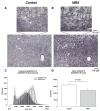Sex, hormones, and stress: how they impact development and function of the carotid bodies and related reflexes
- PMID: 22781657
- PMCID: PMC3782487
- DOI: 10.1016/j.resp.2012.07.001
Sex, hormones, and stress: how they impact development and function of the carotid bodies and related reflexes
Abstract
Progesterone and corticosterone are key modulators of the respiratory control system. While progesterone is widely recognized as an important respiratory stimulant in adult and newborn animals, much remains to be described regarding the underlying mechanisms. We review the potential implication of nuclear and membrane progesterone receptors in adults and in newborns. This raises intriguing questions regarding the contribution of progesterone as a protective factor against some respiratory control disorders during early life. We then discuss our current understanding of the central integration of stressful stimuli and the responses they elicit. The fact that this system interacts with the respiratory control system, either because both share some common neural pathways in the brainstem and hypothalamus, or because corticosterone directly modulates the function of the respiratory control network, is a fascinating field of research that has emerged over the past few years. Finally, we review the short- and long-term consequences of disruption of stress circuitry during postnatal development on these systems.
Copyright © 2012 Elsevier B.V. All rights reserved.
Figures







Similar articles
-
Perinatal steroid exposure and respiratory control during early postnatal life.Respir Physiol Neurobiol. 2005 Nov 15;149(1-3):111-22. doi: 10.1016/j.resp.2005.01.013. Respir Physiol Neurobiol. 2005. PMID: 16203215 Review.
-
Postnatal maturation of breathing stability and loop gain: the role of carotid chemoreceptor development.Respir Physiol Neurobiol. 2013 Jan 1;185(1):144-55. doi: 10.1016/j.resp.2012.06.003. Epub 2012 Jun 13. Respir Physiol Neurobiol. 2013. PMID: 22705011 Review.
-
Stress peptide PACAP engages multiple signaling pathways within the carotid body to initiate excitatory responses in respiratory and sympathetic chemosensory afferents.Am J Physiol Regul Integr Comp Physiol. 2013 Jun 15;304(12):R1070-84. doi: 10.1152/ajpregu.00465.2012. Epub 2013 Apr 17. Am J Physiol Regul Integr Comp Physiol. 2013. PMID: 23594614
-
Neonatal Monitoring: Prediction of Autonomic Regulation at 1 Month from Newborn Assessments.In: Duncan JR, Byard RW, editors. SIDS Sudden Infant and Early Childhood Death: The Past, the Present and the Future. Adelaide (AU): University of Adelaide Press; 2018 May. Chapter 21. In: Duncan JR, Byard RW, editors. SIDS Sudden Infant and Early Childhood Death: The Past, the Present and the Future. Adelaide (AU): University of Adelaide Press; 2018 May. Chapter 21. PMID: 30035942 Free Books & Documents. Review.
-
Neuronal control of breathing: sex and stress hormones.Compr Physiol. 2011 Oct;1(4):2101-39. doi: 10.1002/cphy.c100027. Compr Physiol. 2011. PMID: 23733699 Review.
Cited by
-
Neonatal Maternal Separation Augments Carotid Body Response to Hypoxia in Adult Males but Not Female Rats.Front Physiol. 2016 Sep 27;7:432. doi: 10.3389/fphys.2016.00432. eCollection 2016. Front Physiol. 2016. PMID: 27729873 Free PMC article.
-
Cluster Headache and Hypoxia: Breathing New Life into an Old Theory, with Novel Implications.Neurol Int. 2024 Dec 4;16(6):1691-1716. doi: 10.3390/neurolint16060123. Neurol Int. 2024. PMID: 39728749 Free PMC article. Review.
-
Age Trajectories of O2 Saturation and Levels of Serum Bicarbonate or End-Tidal CO2 Across the Life Course of Women and Men: Insights from EHR and PSG Data.Biomolecules. 2025 Jun 17;15(6):884. doi: 10.3390/biom15060884. Biomolecules. 2025. PMID: 40563523 Free PMC article.
-
Sex-specific vagal and spinal modulation of swallow and its coordination with breathing.PLoS One. 2020 Jun 11;15(6):e0234194. doi: 10.1371/journal.pone.0234194. eCollection 2020. PLoS One. 2020. PMID: 32525920 Free PMC article.
-
Gender Differences in the Context of Obstructive Sleep Apnea and Metabolic Diseases.Front Physiol. 2021 Dec 14;12:792633. doi: 10.3389/fphys.2021.792633. eCollection 2021. Front Physiol. 2021. PMID: 34970158 Free PMC article.
References
-
- Al-Matary A, Kutbi I, Qurashi M, Khalil M, Alvaro R, Kwiatkowski K, Cates D, Rigatto H. Increased peripheral chemoreceptor activity may be critical in destabilizing breathing in neonates. Seminars in Perinatology. 2004;28:264–272. - PubMed
-
- Allen WM. The isolation of crystalline progestin. Science. 1935;82:89–93. - PubMed
-
- Ambach G, Palkovits M. Blood supply of the rat hypothalamus. II. Nucleus paraventricularis. Acta Morphologica Academiae Scientiarum Hungaricae. 1974;22:311–320. - PubMed
-
- Basu M, Sawhney RC, Kumar S, Pal K, Prasad R, Selvamurthy W. Hypothalamic-pituitary-adrenal axis following glucocorticoid prophylaxis against acute mountain sickness. Hormone and Metabolic Research. 2002;34:318–324. - PubMed
Publication types
MeSH terms
Substances
Grants and funding
LinkOut - more resources
Full Text Sources
Other Literature Sources
Medical
Miscellaneous

